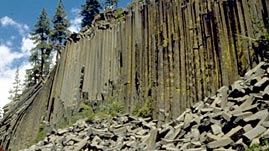Teachers' Domain - Digital Media for the Classroom and Professional Development
User: Preview

Source: National Park Service
Volcanoes provide spectacular evidence that we are living on a dynamic planet, where land can be created or destroyed without regard to human structures or civilizations. This interactive resource adapted from the National Park Service provides an introduction to the wonderful diversity of volcanoes, describing how they form and explaining the great variation in their size and shape and in the processes that created them.
The image most people have of volcanoes is that of a steep-sided, barren cone that spews molten lava down its slopes. This image is depicted in movies, art, and toys, and is often reflected in the volcano models students create for school projects. In reality, while many volcanoes fit this quintessential image, there are countless exceptions to the rule. Volcano slopes may be gentle or their profiles may be jagged and asymmetrical. Dormant volcanoes are often covered with snow and ice, or draped in dense vegetation. In fact, many volcanoes are easily mistaken for non-volcanic mountains that have been formed by the folding and buckling of Earth's crust.
What sets volcanoes apart from other mountains is the manner in which they form. Volcanoes result when magma — a mixture of molten rock, suspended mineral grains, and dissolved gases formed in Earth's interior — is forced to the surface. This occurs most often at the boundaries of tectonic plates, but also at "hot spots" in the interior of these plates.
Scientists recognize four different types of volcanoes, which they categorize according to height, shape, and where and how they formed. The type that most closely resembles the typical volcano image described above is the cinder cone. These relatively small, symmetrical, steep-sided volcanoes usually form on or near other volcanoes of the same or different types. Their shape and vertical structure results from volcanic material being launched nearly straight up into the air during eruptions and then falling back down and settling near the volcano's peak. High concentrations of gas dissolved in the magma of these volcanoes cause these explosive eruptions.
Other types of volcanoes are the lava dome, the composite volcano, and the shield volcano. The lava dome, like the cinder cone, is a relatively small volcano — often called a secondary volcano — that forms on or near another larger volcano. What distinguishes lava domes from cinder cones are their rounded, lumpy shapes that result from the very thick, or viscous, magma that feeds them. Composite volcanoes are typically large and asymmetrical. They can erupt explosively because their magma is both viscous and contains high concentrations of dissolved gas. Shield volcanoes erupt less violently, because their magma is less viscous. Flowing more fluidly, lava erupting from a shield volcano's vent creates gently sloping sides and a more symmetrical shape.
 Loading Standards
Loading Standards Teachers' Domain is proud to be a Pathways portal to the National Science Digital Library.
Teachers' Domain is proud to be a Pathways portal to the National Science Digital Library.
